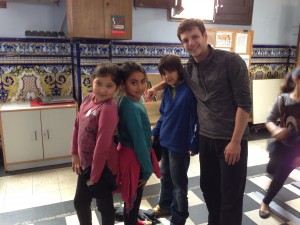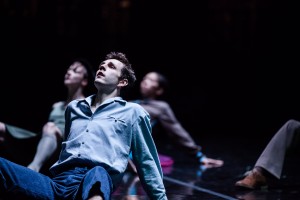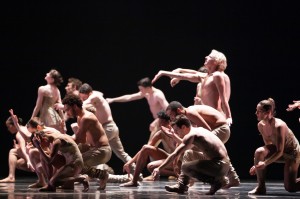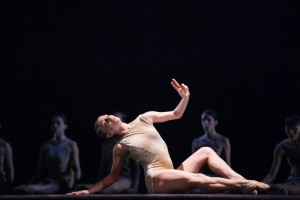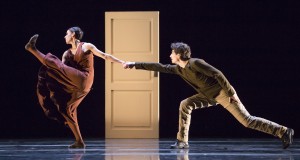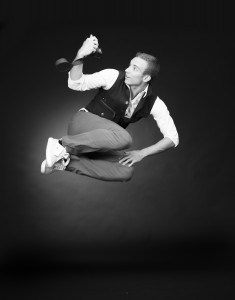Some days my “job” is easy. Case in point, meeting Hubbard Street dancer Kevin Shannon on a Sunday afternoon shortly after he returned from his trip abroad with DanceMotion USA. Shannon along with fellow Hubbard Street dancers Jesse Bechard, Jacqueline Burnett, Meredith Dincolo, Kellie Epperheimer, Jason Hortin, David Schultz, Jessica Tong and their fearless leader Glenn Edgerton, lighting and tech director Matt Miller and Company Manager Ishanee DeVas traveled to North Africa and Spain as cultural ambassadors providing dance workshops and performances.
RB spoke with Shannon in March right before he left, when he talked about the DMUSA program – ie. Part 1. Once he was back in the States, we wanted to have a tapas-style picnic, but the weather did not agree with us, so we met at Cafe Ba-Ba-Reeba. After ordering a pitcher of sangria and a couple of small plates (I ate octupus!). I said, “Ambassador Shannon, tell me everything.” For the most part, my job was done. He proceeded to tell me all about the trip including a number of dancers getting ill requiring performance adjustments, spice markets, a tannery, Moroccan tea, guys on donkey carts, crazy driving and traffic, a lovely day off in Spain and meeting new friends. Here are his stories in his own words. Hint: the word inspiring came up a lot!
First stop – Casablanca: We flew from Chicago to New York, New York to Madrid, Madrid to Casablanca. It’s a long trip. We arrived around 11 in the morning and had a little bit of a break. Everyone was jet-lagged. That evening we had a press conference with the woman from the Embassy. The next day we woke up at 7:30 to start the workshop. It was in a little neighborhood. It was still in Casablanca (the white city). They split us up in two groups and we do two workshops a day. One group was all hip hop. Nobody has any training. They come from the street. There were more men. The culture is not conducive to have women be dancers. A lot of the girls came, but wouldn’t tell their family what they were doing. They were so dedicated. We’d teach them a lot of improvisational and movement technique. What’s it mean to do points in space or to manipulate your body? We even taught ballet to them. There they have folk dancing, hip hop and b-boys. They wanted to learn something different, more contemporary, so they could incorporate it into what they do. It was so cool to see them try to figure it out. They can dance and move, but it’s a different way of thinking and moving. It was really inspiring.
We worked with a group of actors there as well. They did not have dance training at all. We pushed them to think creatively and physically in new ways. Physical dance theater…taking an object and doing exercises with it and around it without words. We worked with people in a detention facility. They were either abandoned by their family or they’d been abused or there was violence within the home where they had to leave. They had girls that were the leaders. I worked with them. To get them to be physical is very difficult. It’s not their culture. The empowerment of women is really important to see. It exists as a whole in certain ways, but it doesn’t exist outside of the home. Or being a physical woman, to dance, to move…they don’t do sports. The men do that. The men are ready to move and be physical, but the woman are more tentative and on the side afraid to do it. It was great to have empowering woman like Meredith and Jac and Kellie and Jess say, ‘no, you can do this’. By the end of the workshop, there was a huge change in their demeanor. Their faces lit up.
On to Marrakesh: Marrakesh was very different. Marrakesh has more tourism. One of the guys asked where we should go eat and they said “McDonald’s!” The McDonald’s were packed. [It was] strange to see that Americanization of certain areas. We were staying at this beautiful hotel. It was strange to be in that Westernized place and then working with students in a studio with the floor falling apart. We had one day to walk around. We went into the spice market. I brought some spices home. I carried them around to Algeria, so when I got home and unpacked, it smelled so pungent. We went to these old French mansions. Everything is hidden behind walls. So you walk in and there’s this beautiful large space, but you don’t see it from the street.
Next stop, Spain: Seville – that was our next journey. It was beautiful. I loved Spain. Morocco is a place to visit. Spain is a place to live. I’d like to go back. We worked with adults with Down Syndrome. It was incredible. They were dancers. The kids with Down Syndrome and the hearing-impaired children were the best students. They were so expressive with emotion. They could just go there. They were so creative and inventive. We did the same type of work. Each workshop was a little different. The place we were teaching the workshops were near this bridge and had a lot of empty spaces. Even though there are a lot of economic issues, there’s still a lot of support for programs like this. In Morocco there’s nothing. We worked with flamenco students as well. They were incredible. We taught them ‘Little Mortal [Jump]’ and sometimes Jason would give a little jazz warm up. They were beautiful. We didn’t get to learn, but we got to watch them. We got to hear them talk about it. They’re just as skilled at what they do as we are. It’s so sexy. A lot of it is improv. They watch the teacher and just pick up what she’s doing. And, the tapas bars are amazing! Valencia is paella city. Beautiful, huge paellas.Valencia was an amazing city. Seville is more traditional, where Valencia is more progressive in the sense of there are more contemporary stores, etc. I would love to go back to Valencia.
And Algeria: And then to the chaos of Algiers. ‘Battle vans’. They were these armored vehicles that were bulletproof. That’s what we traveled in. Algiers was like Morocco, but without the tourism. You don’t see Americans. It’s a police state. They are all over. There are halts and barricades, bomb detectors. Morocco and Algiers don’t have a good relationship. Their borders are closed. In Algeria we worked with Roma children. They are like gypsy families. It was interesting. We’d worked before with the hearing-impaired children. They were so good, so focused. With the Roma children it was like herding cats. Their school is beautiful. It was in an old area that used to be a fishing community. The Roma children are a little darker than typical Spaniards and the culture is less Westernized. Flamenco music is a huge part of that culture. Their identity is music.
We did a performance together with a folkloric company ONCI [Ballet of Algeria] *. I don’t think they were expecting it to be so physical. I taught a movement improv class. They were in shock. They aren’t used to moving that much. The women do their little steps. Some are dancers, but some are more actors. We worked with them for three days. Then we found out a former president had passed away. The country went into eight days of mourning, so all of our performances were cancelled. We ended up doing a performance for the students.
[youtube=https://www.youtube.com/watch?v=O7_cZD6R7EE&feature=player_embedded]
Looking back: It was really inspiring to see dancers without really any training trying to do what we do and then giving us so much back. Sharing movement. It’s just dance. We didn’t have to speak the same language, but the language is dance. It’s the movement. You don’t have to have words. One of the most beautiful parts of this trip is it reminded me that what I do is so extremely important and such a gift. It is a gift to be able to share dance. Dance can be high class or for the middle class or from the streets. It transcends. For me it was very inspiring to come back here and be more inspired to do this again. Sometimes you get burned out and need to be reminded why you do what you do.
Don’t miss Hubbard Street Dance Chicago’s danc(e)volve opening tomorrow night at the MCA Stage, 220 E. Chicago Ave. Most performance dates are already sold out, but tickets are still available for the matinee (3 pm) and evening (7:30 pm) performances on Sunday, June 16.

